Marc Tyler Nobleman's Blog, page 33
May 14, 2018
Meanwhile, at the (real) Hall of Justice…
I suspect I am the first person who has taken a photo like this:
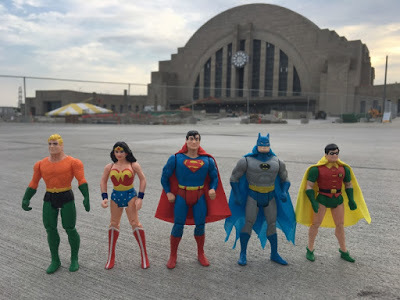
The explanation will tickle some and scare others.
The first line of the opening theme of season one of Super Friends (1973) is "In the great Hall of the Justice League, there are assembled the world's four greatest heroes, created from the cosmic legends of the universe."
This was tweaked slightly for the second incarnation (The All-New Super Friends Hour, 1977): "Gathered together from the cosmic reaches of the universe, here in this great Hall of Justice, are the most powerful forces of good ever assembled."
In both cases, the first name-drop is not any of the characters but rather their headquarters, created for the show. That great Hall of Justice was so great, it became a star in its own right.
And it's based on a building in Cincinnati: what was originally called Union Terminal, a distinctive Art Deco train station built in 1933.
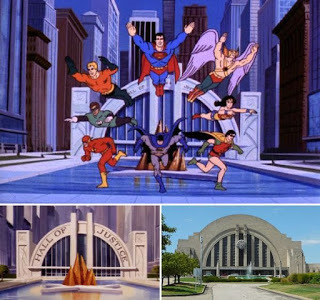 courtesy of Rain Noe/Core 77
courtesy of Rain Noe/Core 77
Soon after, the dominance of rail service waned. Union Terminal was then repurposed multiple times (once as a mall and currently as a multi-purpose facility including museums, a library, and an IMAX theater). In between reinventions, it remained unoccupied. It evaded demolition at least once and is now protected with landmark status (granted only a few months before Super Friends debuted).
You may think me batty (or not), but not only did I make a special trip from Dayton (where I spent a week for school visits) to Cincinnati (one hour one way) to see it, but before the Dayton schools brought me to Ohio, I even tried to book speaking engagements in Cincinnati (where I'd never been) so I could go to Union Terminal.
I did so the warm weekend afternoon of 5/12/18. The site is under renovation so I did not get an unobstructed view. Therefore, unfortunately, my photos have fences and equipment in the background—but no people, because the place was deserted. It was surreal enough to be standing before the real-life Hall of Justice and even more so to be there alone.
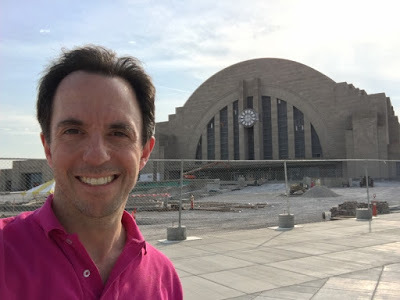
But then around 5:30 pm, people began dropping off kids with sleeping bags…turns out the Girl Scouts was holding a sleepover there that night. Gathered together from the city limits of Cincinnati…
Side note (literally): the building is adjacent to Kenner Street, which I found apropos in that Kenner was the toy company that produced Super Powers action figures. The line launched in 1984, a tie-in to the last two incarnations of the Super Friends cartoon.
I owned the first two waves of figures, and as you saw at the top, I still have them. I dug them out so I could bring the original five Super Friends for this geeky photo shoot. (I even remember the order of some of the purchases from when I was 12. The first figure I got was Joker. The next two were Green Lantern and Aquaman at the same time. I also remember other pairs I got at the same time—Superman and Flash one day, Hawkman and Penguin another.)
Another side note: Ohio is also home to the creation of Superman, but I'd already been to Cleveland.
Farewell, great Hall.


The explanation will tickle some and scare others.
The first line of the opening theme of season one of Super Friends (1973) is "In the great Hall of the Justice League, there are assembled the world's four greatest heroes, created from the cosmic legends of the universe."
This was tweaked slightly for the second incarnation (The All-New Super Friends Hour, 1977): "Gathered together from the cosmic reaches of the universe, here in this great Hall of Justice, are the most powerful forces of good ever assembled."
In both cases, the first name-drop is not any of the characters but rather their headquarters, created for the show. That great Hall of Justice was so great, it became a star in its own right.
And it's based on a building in Cincinnati: what was originally called Union Terminal, a distinctive Art Deco train station built in 1933.
 courtesy of Rain Noe/Core 77
courtesy of Rain Noe/Core 77Soon after, the dominance of rail service waned. Union Terminal was then repurposed multiple times (once as a mall and currently as a multi-purpose facility including museums, a library, and an IMAX theater). In between reinventions, it remained unoccupied. It evaded demolition at least once and is now protected with landmark status (granted only a few months before Super Friends debuted).
You may think me batty (or not), but not only did I make a special trip from Dayton (where I spent a week for school visits) to Cincinnati (one hour one way) to see it, but before the Dayton schools brought me to Ohio, I even tried to book speaking engagements in Cincinnati (where I'd never been) so I could go to Union Terminal.
I did so the warm weekend afternoon of 5/12/18. The site is under renovation so I did not get an unobstructed view. Therefore, unfortunately, my photos have fences and equipment in the background—but no people, because the place was deserted. It was surreal enough to be standing before the real-life Hall of Justice and even more so to be there alone.

But then around 5:30 pm, people began dropping off kids with sleeping bags…turns out the Girl Scouts was holding a sleepover there that night. Gathered together from the city limits of Cincinnati…
Side note (literally): the building is adjacent to Kenner Street, which I found apropos in that Kenner was the toy company that produced Super Powers action figures. The line launched in 1984, a tie-in to the last two incarnations of the Super Friends cartoon.
I owned the first two waves of figures, and as you saw at the top, I still have them. I dug them out so I could bring the original five Super Friends for this geeky photo shoot. (I even remember the order of some of the purchases from when I was 12. The first figure I got was Joker. The next two were Green Lantern and Aquaman at the same time. I also remember other pairs I got at the same time—Superman and Flash one day, Hawkman and Penguin another.)
Another side note: Ohio is also home to the creation of Superman, but I'd already been to Cleveland.
Farewell, great Hall.

Published on May 14, 2018 04:00
May 12, 2018
Scholastic's "50 Magical Books for Summer"
Although summer and fairies go together, that is no guarantee that a book about fairies would make a list called "50 Magical Books for Summer."
In this case, however, Fairy Spell: How Two Girls Convinced the World That Fairies Are Real, has, and I'm honored. Thank you, Scholastic!
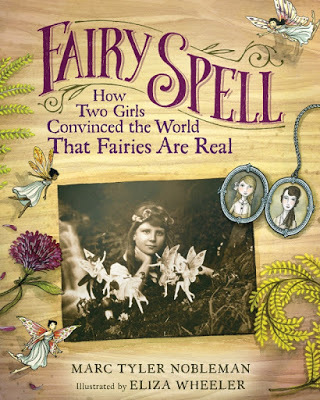
In this case, however, Fairy Spell: How Two Girls Convinced the World That Fairies Are Real, has, and I'm honored. Thank you, Scholastic!

Published on May 12, 2018 04:00
May 10, 2018
Double honor in joining this Wall of Fame
At the top of the 2017-18 school year, librarian Marcie Atkins at Belvedere Elementary in Falls Church, VA began curating a Wall of Fame consisting of placards indicating authors who have spoken at the school. Effective 5/4/18, that included me.
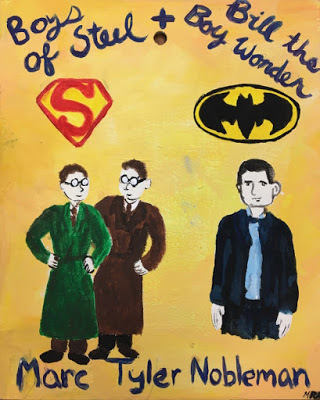
I'm honored to be on it, and doubly honored that my placard, like the others, was wonderfully illustrated by Marcie's daughter, who is currently 13.
Thank you again to both of you!

I'm honored to be on it, and doubly honored that my placard, like the others, was wonderfully illustrated by Marcie's daughter, who is currently 13.
Thank you again to both of you!
Published on May 10, 2018 04:00
May 9, 2018
May 4 is now Bill Finger Day in Massachusetts
Bill Finger was born on February 8, 1914.
He died on January 18, 1974.
His first biography, Bill the Boy Wonder: The Secret Co-Creator of Batman, released on July 1, 2012.
DC Comics announced on September 18, 2015 that the company would be officially adding his name to the Batman credit line.
That credit line first appeared in print (in an ad) on October 10, 2015.
The corrected credit first appeared on TV on October 19, 2015 (Robot Chicken DC Comics Special III: Magical Friendship) and first appeared in the credits of an ongoing series (Gotham) later that same day.
Two days later, on October 21, 2015, the co-creator credit first appeared in the credits box of a comic book (three series that day).
Batman & Bill, the documentary about him, began streaming on May 6, 2017.
New York City renamed a street for him on December 8, 2017.
So many dates worth acknowledging...and now...
Massachusetts has declared May 4 "Bill Finger Day."
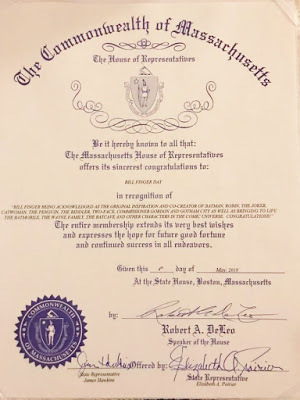
Bill's granddaughter Athena grew up in Massachusetts and was in the state on May 4 to attend the premiere of the second production of Co-Creator, a play about Bill, after which she was surprised with a live announcement of the proclamation.
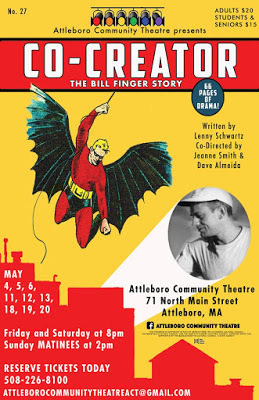
Thank you to Dave Almeida (co-director of the play) and all others who had a role in establishing this honor. Congrats and best of luck on the play! I'm disappointed I could not make it this time.
What's next? Bill Finger leisurewear? Limited Edition Bill Finger Butterfingers? Will Bill become the mascot for a NFL team? (The Buffalo Bills would not have to change their merchandise...)
He died on January 18, 1974.
His first biography, Bill the Boy Wonder: The Secret Co-Creator of Batman, released on July 1, 2012.
DC Comics announced on September 18, 2015 that the company would be officially adding his name to the Batman credit line.
That credit line first appeared in print (in an ad) on October 10, 2015.
The corrected credit first appeared on TV on October 19, 2015 (Robot Chicken DC Comics Special III: Magical Friendship) and first appeared in the credits of an ongoing series (Gotham) later that same day.
Two days later, on October 21, 2015, the co-creator credit first appeared in the credits box of a comic book (three series that day).
Batman & Bill, the documentary about him, began streaming on May 6, 2017.
New York City renamed a street for him on December 8, 2017.
So many dates worth acknowledging...and now...
Massachusetts has declared May 4 "Bill Finger Day."

Bill's granddaughter Athena grew up in Massachusetts and was in the state on May 4 to attend the premiere of the second production of Co-Creator, a play about Bill, after which she was surprised with a live announcement of the proclamation.

Thank you to Dave Almeida (co-director of the play) and all others who had a role in establishing this honor. Congrats and best of luck on the play! I'm disappointed I could not make it this time.
What's next? Bill Finger leisurewear? Limited Edition Bill Finger Butterfingers? Will Bill become the mascot for a NFL team? (The Buffalo Bills would not have to change their merchandise...)
Published on May 09, 2018 04:00
May 8, 2018
Lyn Simmons (Bill Finger's second wife), 1922-2018
One of the last of Bill Finger's generation who knew him personally has left us: his second wife, Lyn (originally Edith) Simmons. On 5/2/18, she passed away at age 95.
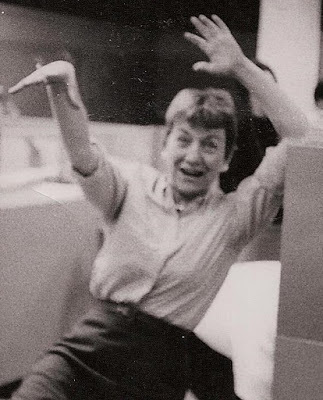 Lyn in the 1960s
Lyn in the 1960s
She was a mother, a grandmother, an artist, an advocate, and other things I don't know about. To me, she was first and foremost a critical living link to an important and emotional untold story.
When I started my Finger research in 2006, we knew Bill had been married…to a woman named Portia. We did not know that Bill and Portia divorced and that Bill remarried Lyn later in life. Bill's second wife was the second person I found in my research (after Charles Sinclair, Bill's longtime writing partner, who died in November 2017 at age 93).
Surprisingly, I was the first author to reach out to Lyn about Bill.
But I was not the first writer.
While making the documentary Batman & Bill, I was asked who the heroes of the Bill Finger story are. One of the first who came to mind was Lyn. In 1989, in the run-up to Tim Burton's film Batman, Lyn almost single-handedly lobbied Warner Bros. to include Bill's name in the credits. She apparently also contacted some journalists.
As that paper trail shows, her son Steve helped and she got close…but was ultimately unsuccessful. That made it no less inspirational because Lyn did it solely for Bill. She wanted no money and offered to sign a waiver to that effect.
What makes this even more admirable: by the time Bill died in 1974, Lyn was his ex-wife. They'd met in 1954, married in 1968 (no photos were taken, alas), and divorced in 1971. Another of Lyn's three children, Andrew, had a serious car accident in California at age 22; Lyn decided to move there to help take care of him but Bill did not want to go. (In fact, he was averse to flying and never went on a plane in his life.) Perhaps there were other factors contributing to their separation, but Lyn told me that she and Bill stayed in touch, regularly speaking on the phone. Had he lived, she felt they would've gotten back together. Lyn stayed to help her son for 12 years.
Lyn's oldest child, Steve, and her youngest, Eve, proved invaluable in my research.
I found Lyn via Eve via her high school in Great Neck, NY. (The person I spoke with there said they are not at liberty to provide information about their graduates, but when I said this was about the secret history of Batman, he made an exception.) I left messages on the answering machines of more than one Eve or E. Simmons in New York and by chance one of them was the one I needed—and by chance she took the time to call me back. I asked what she remembered about what her mom told her about Bill, and she shared a recollection or two. Then she said "Why don't you ask her yourself?" I said "Oh, I didn't think she was still alive!"
Lyn and I first spoke almost immediately after, on 6/23/06. She was a delight from start to finish, each time we spoke. And though I did not need further motivation to pursue this story, Lyn sure infused me with a greater sense of urgency (and poignancy).
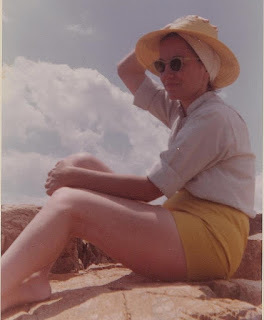 again in the '60s
again in the '60s
She told me that Steve had a great photo of Bill that Steve had used in a birthday slide show for Lyn, so I emailed Steve to ask if he could email me a scan. He kindly said he'd first have to look for it. Seven months later, he found it. I was so excited that I emailed him several questions including "Where do you live?" Turns out Steve lived in…the exact same town as I did at the time. Meaning the photo was five minutes away from me the whole time.
That photo is of one of the clearest (and definitely the quirkiest) of the 12 "new" Bill Finger photos I uncovered: Bill fertilizing the lawn at Lyn's house in Roslyn, NY—topless (the photo is in Bill the Boy Wonder: The Secret Co-Creator of Batman). Lyn told me "One of my neighbors objected to Bill not having a shirt on even though the temperature was about 100 degrees. We ignored [that person]."
In that first talk, Lyn expressed gratitude that I was doing this. I told her I'd like to get Bill a proper burial; she didn't know he didn't have a headstone. She later said she'd like to cover the cost for one.
A few days later, in our second talk, she said she'd found her Bill file, which included a letter she'd written him (most likely in the early '70s) in which she said she was on her third Scotch. "If you publish the book," she said, "please change it to 'second.'" (No mention of alcohol made it into the final draft of the picture book aimed at young readers.)
On 7/30/06, she emailed "How old are you, Marc? I'm just curious because you're involved now with the 80s generation [meaning people in their eighties] and you seem to be handling it all very well." It wasn't hard, Lyn. Certainly not with you.
Lyn remembered Bill's scarab paperweight that Charles had given me. She had bought it for Bill (or possibly the other way around) at a New York museum gift shop.
Thanks to Lyn, we learned Bill's birth name was Milton, which enabled me to find his high school yearbook photo, the earliest known Bill Finger photo in existence. Knowing his given name also confirmed that his family does indeed appear in the census. At first I missed them because I was looking for a Bill (not Milton) Finger but saw none. And in confirming which census listings were his, I discovered that he had not one but two sisters, Emily and Gilda.
For all Lyn knew, there were two big things she did not know. One: Bill had siblings. It appears he never told her. Two: Bill had a granddaughter. But that makes more sense as Athena was born two years after Bill died.
In 1974, after Lyn had not heard from Bill when she expected to, she asked Charles (whom she called Charlie) to look in on him. The way Charles found Bill dead is devastatingly recreated in the documentary. Charles asked Lyn if she was psychic.
I met in Lyn in person for the first time on 6/7/07, at a Starbucks. She said she hoped she'd still be alive when my book came out. (At that point, I had not even sold it—and wouldn't for three more years.) We filmed her twice for the documentary—first in 2008 (for an attempt that would implode), next in 2016. Clips from both interviews are in the finished film and the difference in Lyn in those eight years is striking.
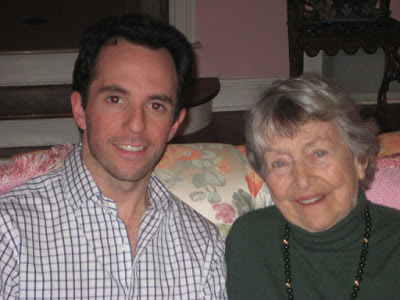 2008
2008
Bill the Boy Wonder is dedicated to three people: Athena, Charles, and Lyn. I called her the "heart" of Bill Finger. She was also the heart of my book, and I am one of many who will miss her.
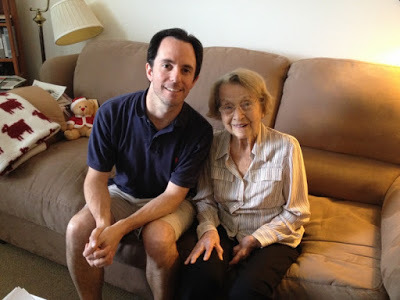 2014, the last time I saw Lyn in person
2014, the last time I saw Lyn in person
Thank you, Lyn. It took 25 years longer than you had hoped, but mission accomplished.
 Lyn in the 1960s
Lyn in the 1960sShe was a mother, a grandmother, an artist, an advocate, and other things I don't know about. To me, she was first and foremost a critical living link to an important and emotional untold story.
When I started my Finger research in 2006, we knew Bill had been married…to a woman named Portia. We did not know that Bill and Portia divorced and that Bill remarried Lyn later in life. Bill's second wife was the second person I found in my research (after Charles Sinclair, Bill's longtime writing partner, who died in November 2017 at age 93).
Surprisingly, I was the first author to reach out to Lyn about Bill.
But I was not the first writer.
While making the documentary Batman & Bill, I was asked who the heroes of the Bill Finger story are. One of the first who came to mind was Lyn. In 1989, in the run-up to Tim Burton's film Batman, Lyn almost single-handedly lobbied Warner Bros. to include Bill's name in the credits. She apparently also contacted some journalists.
As that paper trail shows, her son Steve helped and she got close…but was ultimately unsuccessful. That made it no less inspirational because Lyn did it solely for Bill. She wanted no money and offered to sign a waiver to that effect.
What makes this even more admirable: by the time Bill died in 1974, Lyn was his ex-wife. They'd met in 1954, married in 1968 (no photos were taken, alas), and divorced in 1971. Another of Lyn's three children, Andrew, had a serious car accident in California at age 22; Lyn decided to move there to help take care of him but Bill did not want to go. (In fact, he was averse to flying and never went on a plane in his life.) Perhaps there were other factors contributing to their separation, but Lyn told me that she and Bill stayed in touch, regularly speaking on the phone. Had he lived, she felt they would've gotten back together. Lyn stayed to help her son for 12 years.
Lyn's oldest child, Steve, and her youngest, Eve, proved invaluable in my research.
I found Lyn via Eve via her high school in Great Neck, NY. (The person I spoke with there said they are not at liberty to provide information about their graduates, but when I said this was about the secret history of Batman, he made an exception.) I left messages on the answering machines of more than one Eve or E. Simmons in New York and by chance one of them was the one I needed—and by chance she took the time to call me back. I asked what she remembered about what her mom told her about Bill, and she shared a recollection or two. Then she said "Why don't you ask her yourself?" I said "Oh, I didn't think she was still alive!"
Lyn and I first spoke almost immediately after, on 6/23/06. She was a delight from start to finish, each time we spoke. And though I did not need further motivation to pursue this story, Lyn sure infused me with a greater sense of urgency (and poignancy).
 again in the '60s
again in the '60sShe told me that Steve had a great photo of Bill that Steve had used in a birthday slide show for Lyn, so I emailed Steve to ask if he could email me a scan. He kindly said he'd first have to look for it. Seven months later, he found it. I was so excited that I emailed him several questions including "Where do you live?" Turns out Steve lived in…the exact same town as I did at the time. Meaning the photo was five minutes away from me the whole time.
That photo is of one of the clearest (and definitely the quirkiest) of the 12 "new" Bill Finger photos I uncovered: Bill fertilizing the lawn at Lyn's house in Roslyn, NY—topless (the photo is in Bill the Boy Wonder: The Secret Co-Creator of Batman). Lyn told me "One of my neighbors objected to Bill not having a shirt on even though the temperature was about 100 degrees. We ignored [that person]."
In that first talk, Lyn expressed gratitude that I was doing this. I told her I'd like to get Bill a proper burial; she didn't know he didn't have a headstone. She later said she'd like to cover the cost for one.
A few days later, in our second talk, she said she'd found her Bill file, which included a letter she'd written him (most likely in the early '70s) in which she said she was on her third Scotch. "If you publish the book," she said, "please change it to 'second.'" (No mention of alcohol made it into the final draft of the picture book aimed at young readers.)
On 7/30/06, she emailed "How old are you, Marc? I'm just curious because you're involved now with the 80s generation [meaning people in their eighties] and you seem to be handling it all very well." It wasn't hard, Lyn. Certainly not with you.
Lyn remembered Bill's scarab paperweight that Charles had given me. She had bought it for Bill (or possibly the other way around) at a New York museum gift shop.
Thanks to Lyn, we learned Bill's birth name was Milton, which enabled me to find his high school yearbook photo, the earliest known Bill Finger photo in existence. Knowing his given name also confirmed that his family does indeed appear in the census. At first I missed them because I was looking for a Bill (not Milton) Finger but saw none. And in confirming which census listings were his, I discovered that he had not one but two sisters, Emily and Gilda.
For all Lyn knew, there were two big things she did not know. One: Bill had siblings. It appears he never told her. Two: Bill had a granddaughter. But that makes more sense as Athena was born two years after Bill died.
In 1974, after Lyn had not heard from Bill when she expected to, she asked Charles (whom she called Charlie) to look in on him. The way Charles found Bill dead is devastatingly recreated in the documentary. Charles asked Lyn if she was psychic.
I met in Lyn in person for the first time on 6/7/07, at a Starbucks. She said she hoped she'd still be alive when my book came out. (At that point, I had not even sold it—and wouldn't for three more years.) We filmed her twice for the documentary—first in 2008 (for an attempt that would implode), next in 2016. Clips from both interviews are in the finished film and the difference in Lyn in those eight years is striking.
 2008
2008Bill the Boy Wonder is dedicated to three people: Athena, Charles, and Lyn. I called her the "heart" of Bill Finger. She was also the heart of my book, and I am one of many who will miss her.
 2014, the last time I saw Lyn in person
2014, the last time I saw Lyn in personThank you, Lyn. It took 25 years longer than you had hoped, but mission accomplished.
Published on May 08, 2018 04:00
May 7, 2018
Machu Picchu: my third of the Seven Wonders
On 4/29/18, my bucket list got a little lighter.
After speaking for a week at an international school in Lima, I visited Machu Picchu, one of the New Seven Wonders of the World (and the third I've had the privilege to see, the other two being the Colosseum in 1993 and the Taj Mahal in 2015).
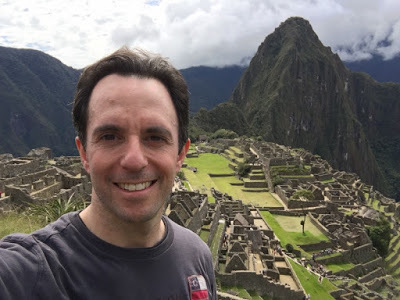
It earns that distinction.
A trip to Machu Picchu starts with a stop in Cusco (once the capital of the Inca Empire) followed by a stone-skip in the much smaller town Aguas Calientes (also called Machupicchu, one word). Think of them as base camps 1 and 2.
Moodily nestled in a cloud forest between highlands and jungle, Machu Picchu is lower in elevation than Cusco (and higher than Aguas Calientes). Some people develop altitude sickness in Cusco, symptoms of which can include headache and nausea.

So going from Cusco to Machu Picchu can alleviate that discomfort—due not only to elevation but also elation.
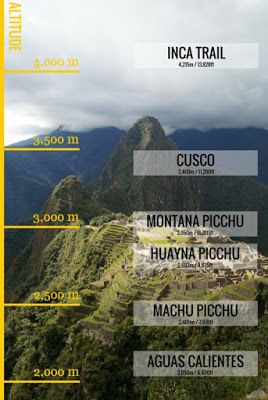
Glimpses of Cusco:
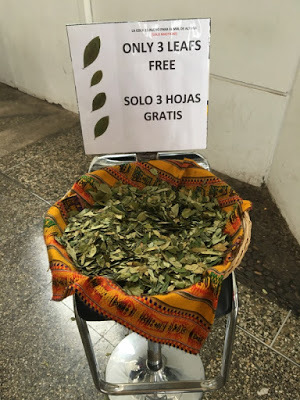 Chewing coca leaves (yes, coca as in cocaine)allegedly helps alleviate altitude sickness symptoms.
Chewing coca leaves (yes, coca as in cocaine)allegedly helps alleviate altitude sickness symptoms.
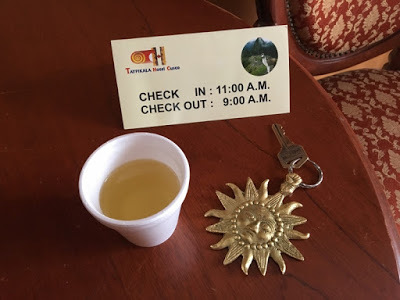 So does drinking coca tea, offered for free in many hotels.
So does drinking coca tea, offered for free in many hotels.
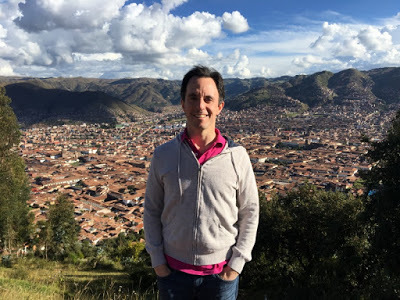
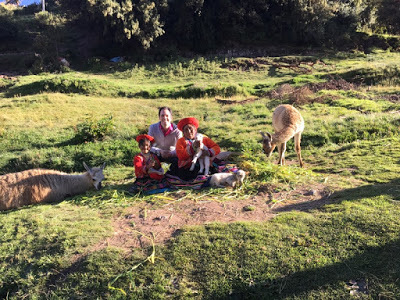
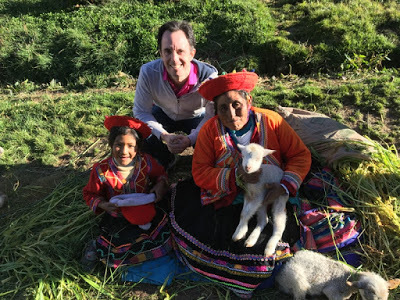
 For me, the highlight of Cucso was the large stone Incan fortress/complex Sacsayhuamán.
For me, the highlight of Cucso was the large stone Incan fortress/complex Sacsayhuamán.
Getting to Machu Picchu, step by step (though not as many steps as hiking there on the Inca Trail):
1 hour, 20 minute flight from Lima to Cusco2-hour private bus to Ollantaytambo2-hour Inca Rail train to Aguas Calientes 20-minute bus to the gate of Machu Picchu
That last leg is mundane on the surface but exhilarating as you are so close to entering one of the most legendary locales in human history.
I did all but the flight in one day, meaning about eight hours of travel for three hours of tourism. But again, as I keep saying: Machu Picchu. Mucho worth it.
My timeline:
3:30 am—alarm went off after an altitude-impacted night of half-sleep: dry mouth, cold-like congestion, mildly feverish; all that remained as I set out was head pressure (not quite a headache)4 am—picked up at hotel by rep from the travel agency, but he did not have one key item he was supposed to: my train ticket (note: when I entered the dimly lit hotel lobby, two hotel staff member who were sleeping on the vinyl couches awoke with a start); though I was not told why, I was driven to another hotel where lots of people were waiting and where, after at least 20 minutes of bumbling, the travel agency rep managed to produce the train ticket 4:50 am—private bus with about 20 others to Ollantaytambo; sure enough, as our altitude decreased, my head pressure dissipated 7:20 am—Inca Rail to Aguas Calientes9 am—arrived at Aguas Calientes; I felt like I'd already traveled a full day and it was only the start of work according to the traditional schedule 10 am—after tooling around the tiny town (which is mostly tourist restaurants selling pizza but also has several discos and even a soccer field), I took the bus to Machu Picchu11 am—met my guide Anibal and entered Machu Picchu; his best line of the day: "Welcome to my office" (perhaps you've had a tour guide somewhere who's said the same)12:50 pm—after exploring from one end to another, we began to hike the portion of the Inca Trail that leads to the Sun Gate; I'd been told it would take 45 minutes one way so we hauled (because I could not miss my train back) and made it in 252 pm—after hiking back down, we left Machu Picchu4:12 pm—train back to bus back to Cusco8:30 pm—I arrived in Cusco, but to the departure hotel from that morning; apparently the travel agency forgot to provide a ride for that last step (10 minute drive to my hotel); luckily, other travel agency people who were there (I don't know exactly who they were) kindly drove me
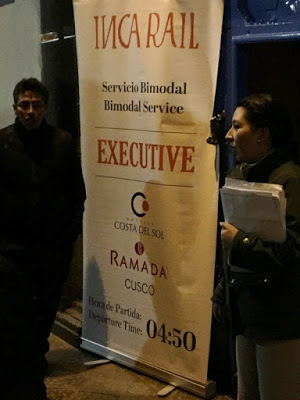
 Catching the train in Ollantaytambo.
Catching the train in Ollantaytambo.
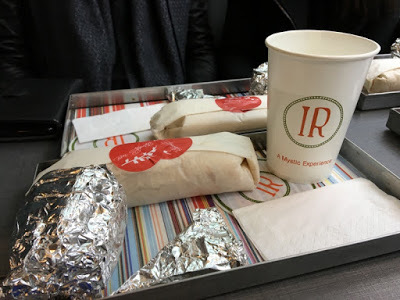 I don't know if the "mystic experience" refers to the train ride or to the small meal included.
I don't know if the "mystic experience" refers to the train ride or to the small meal included.
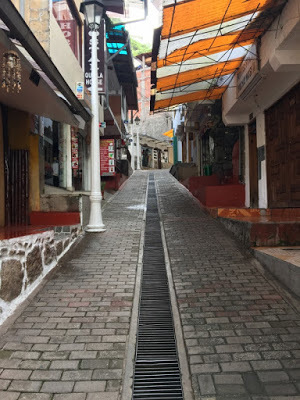 Aguas Calientes is essentially one angled street.
Aguas Calientes is essentially one angled street.
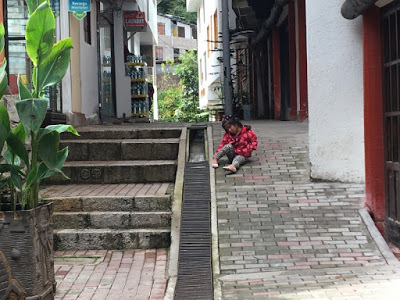
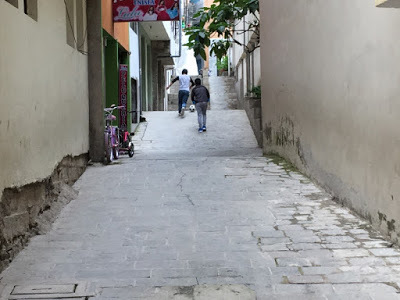
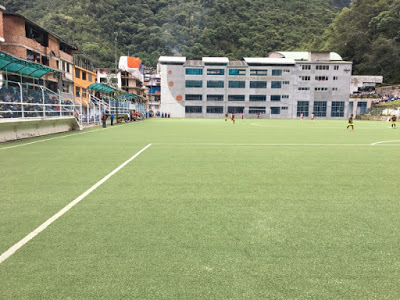 Though small and somewhat claustrophic, Aguas Calientes is home to a proper soccer field that took me by surprise when I stumbled upon it.
Though small and somewhat claustrophic, Aguas Calientes is home to a proper soccer field that took me by surprise when I stumbled upon it.
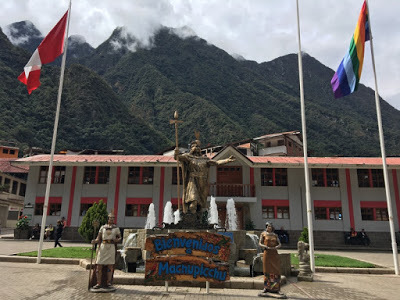 The central plaza displays what appears to be the
The central plaza displays what appears to be the
gay pride flag but is actually the flag of Cusco.
(Thank you to those who corrected me.)
Some theorize this pattern also appeared on an Incan flag,
though others say that is unlikely.
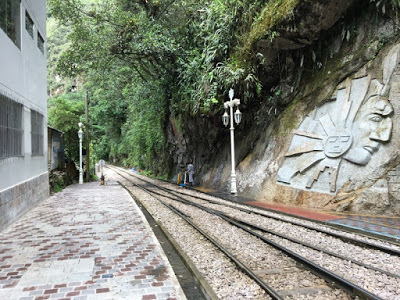 Follow the train tracks just a bit and the town simply ends.
Follow the train tracks just a bit and the town simply ends.
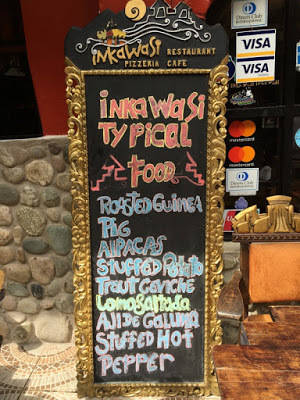 ROASTED GUINEA PIG.
ROASTED GUINEA PIG.
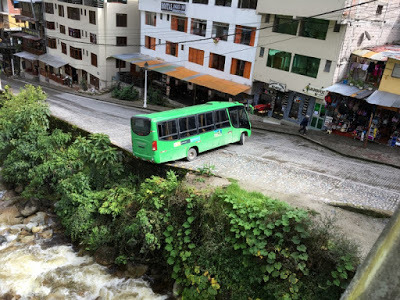 One of the buses that leave every few minutes to/fromMachu Picchu. Looked like this one was about to back up right into the river...
One of the buses that leave every few minutes to/fromMachu Picchu. Looked like this one was about to back up right into the river...
Up until somewhat recently, only morning tours were offered. Due to demand, they added an afternoon option ("secondo turno"). That's what I chose for several reasons:
rain/fog are more likely in the morning (and the sun rises behind a mountain)best light for photos is around 4 pm (though it turns out I was not able to stay that late)crowd thins after 3 pm (ditto)it's the only way a day trip from Cusco is possible
Total steps for the day: 18,000. Though I exceeded my 10,000-a-day goal, I thought it'd be more. (Plus each step to and from the Sun Gate should count as two.)
The expansive citadel of Machu Picchu was—staggeringly—built and abandoned within about 100 years (mid-1400s to mid-1500s). This is even more incomprehensible given how many stone structures are there and how painstakingly they were built—without mortar (more than 400 years later, you cannot fit a thin blade between the bricks). Incan construction has survived earthquakes better than more modern techniques. All of the rock used was quarried on site.
Animals you might see at Machu Picchu include llamas, monkeys, and hummingbirds. Animals I saw included llamas. That's it. Oh, and butterflies.
I asked Anibal why most of the AC cafés offered pizza, which isn't Peruvian and certainly isn't Incan. He said because it's easy and quick to make. I suggested he start a place called "Machu Pizza." I think he's considering it.
Glorious glimpses of Machu Picchu:
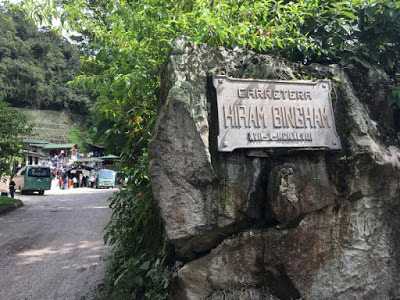 Hiram Bingham was the American explorer who(re)discovered Machu Picchu in 1911 and publicized it to the world.
Hiram Bingham was the American explorer who(re)discovered Machu Picchu in 1911 and publicized it to the world.
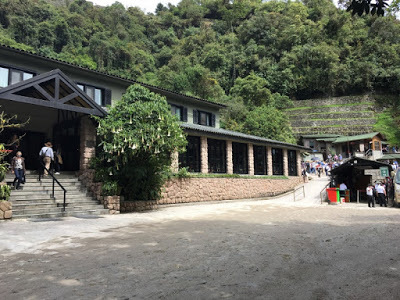 In the 1980s, a luxury ($1,900/night when I looked)hotel was built just outside Machu Picchu.
In the 1980s, a luxury ($1,900/night when I looked)hotel was built just outside Machu Picchu.
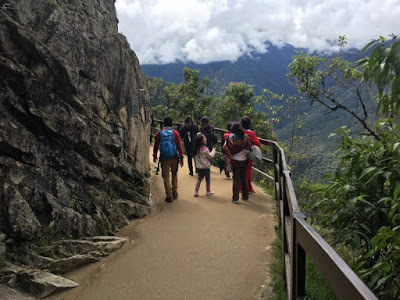 Round this corner and...
Round this corner and...
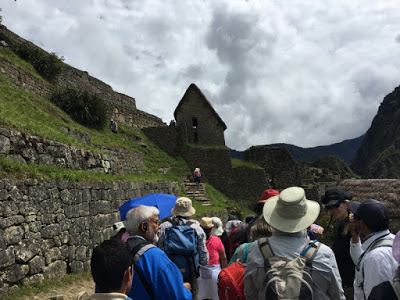 ...first glimpse of Machu Picchu.
...first glimpse of Machu Picchu.
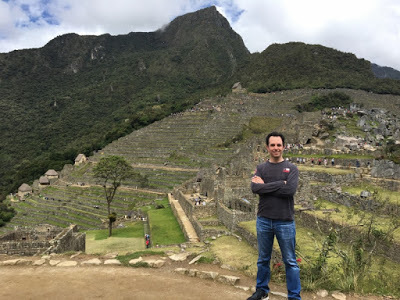
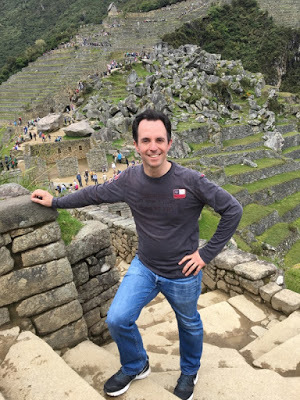
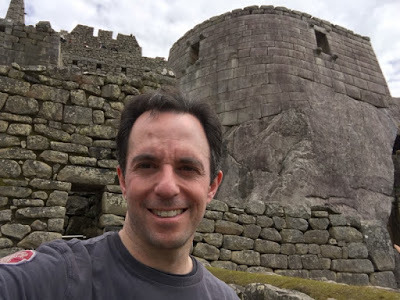 Temple of the Sun, a centerpiece of Machu Picchu andthe only structure there with rounded walls.
Temple of the Sun, a centerpiece of Machu Picchu andthe only structure there with rounded walls.
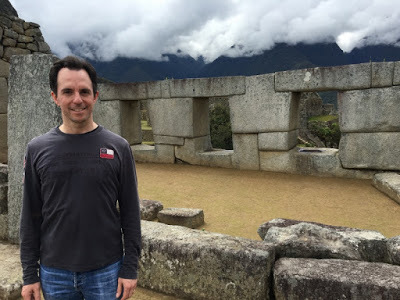 Room of the Three Windows, another religiously significant highlight.
Room of the Three Windows, another religiously significant highlight.
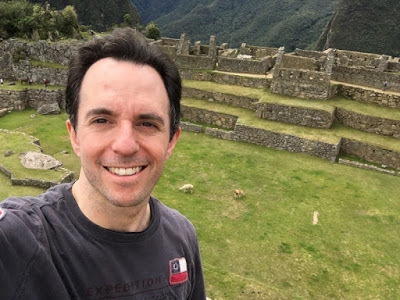 See that small white line of stone on the grass right of center?
See that small white line of stone on the grass right of center?
Once there was a larger stone there, but when the King of Spainrequested to land his helicopter on that spot in 1978, it was removed. As if the Spanish hadn't already done enoughdamage to the Incas!
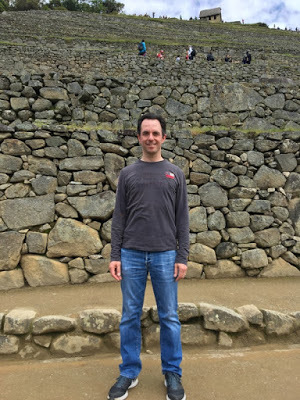
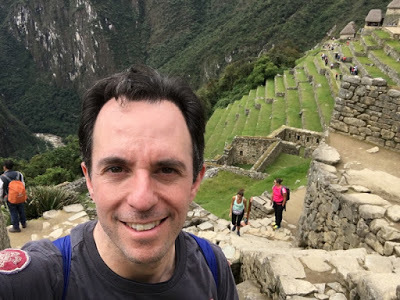 To give a sense of the depth/steepness.
To give a sense of the depth/steepness.
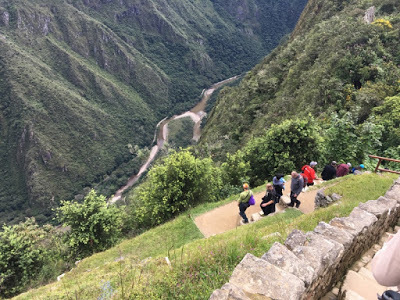 To give a deeper sense of the depth. Note the river far below.
To give a deeper sense of the depth. Note the river far below.
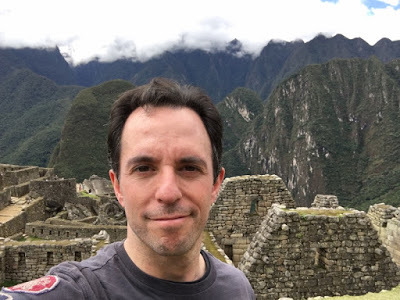
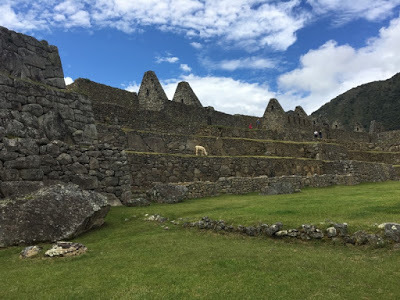 Llamas and alpacas graze and roam the site.
Llamas and alpacas graze and roam the site.
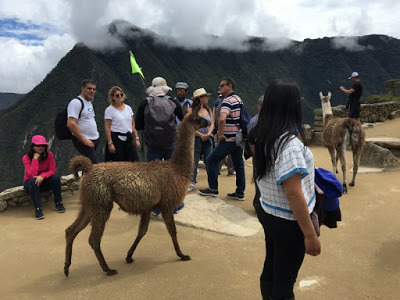
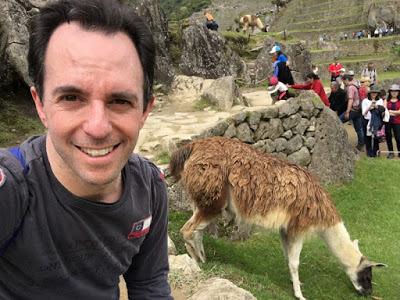
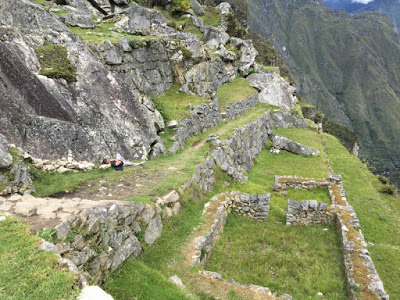 Spot the resting tourist.
Spot the resting tourist.
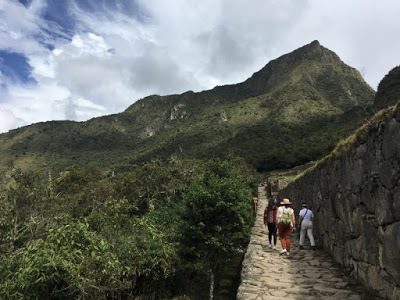 Take this stretch of the Inca Trail from Machu Picchuto the Sun Gate, a majestic and astronomically pivotal site
Take this stretch of the Inca Trail from Machu Picchuto the Sun Gate, a majestic and astronomically pivotal site
on the crest of that mountain in the distance.
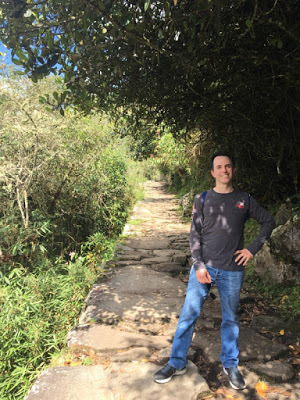 Except for my clothes, this scene could havebeen 500 years ago.
Except for my clothes, this scene could havebeen 500 years ago.
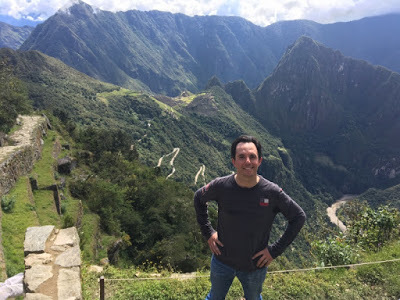 A view of Machu Picchu from the Sun Gate.
A view of Machu Picchu from the Sun Gate.
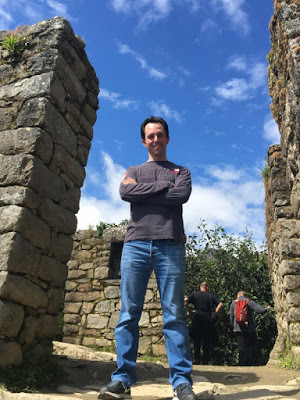 A view of me at the Sun Gate.
A view of me at the Sun Gate.
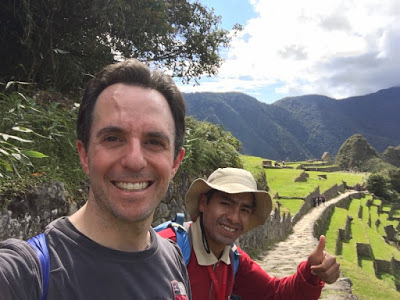 Thanks again, Anibal!
Thanks again, Anibal!
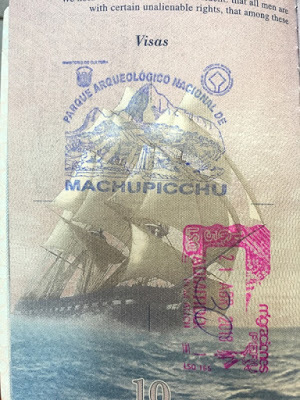 You can get a free Machu Picchu stamp in your passport.
You can get a free Machu Picchu stamp in your passport.
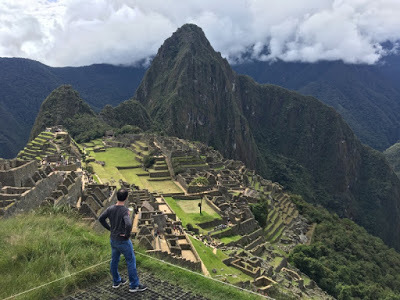 And a free Machu Picchu stamp on your spirit.
And a free Machu Picchu stamp on your spirit.
After speaking for a week at an international school in Lima, I visited Machu Picchu, one of the New Seven Wonders of the World (and the third I've had the privilege to see, the other two being the Colosseum in 1993 and the Taj Mahal in 2015).

It earns that distinction.
A trip to Machu Picchu starts with a stop in Cusco (once the capital of the Inca Empire) followed by a stone-skip in the much smaller town Aguas Calientes (also called Machupicchu, one word). Think of them as base camps 1 and 2.
Moodily nestled in a cloud forest between highlands and jungle, Machu Picchu is lower in elevation than Cusco (and higher than Aguas Calientes). Some people develop altitude sickness in Cusco, symptoms of which can include headache and nausea.

So going from Cusco to Machu Picchu can alleviate that discomfort—due not only to elevation but also elation.

Glimpses of Cusco:
 Chewing coca leaves (yes, coca as in cocaine)allegedly helps alleviate altitude sickness symptoms.
Chewing coca leaves (yes, coca as in cocaine)allegedly helps alleviate altitude sickness symptoms. So does drinking coca tea, offered for free in many hotels.
So does drinking coca tea, offered for free in many hotels.


 For me, the highlight of Cucso was the large stone Incan fortress/complex Sacsayhuamán.
For me, the highlight of Cucso was the large stone Incan fortress/complex Sacsayhuamán. Getting to Machu Picchu, step by step (though not as many steps as hiking there on the Inca Trail):
1 hour, 20 minute flight from Lima to Cusco2-hour private bus to Ollantaytambo2-hour Inca Rail train to Aguas Calientes 20-minute bus to the gate of Machu Picchu
That last leg is mundane on the surface but exhilarating as you are so close to entering one of the most legendary locales in human history.
I did all but the flight in one day, meaning about eight hours of travel for three hours of tourism. But again, as I keep saying: Machu Picchu. Mucho worth it.
My timeline:
3:30 am—alarm went off after an altitude-impacted night of half-sleep: dry mouth, cold-like congestion, mildly feverish; all that remained as I set out was head pressure (not quite a headache)4 am—picked up at hotel by rep from the travel agency, but he did not have one key item he was supposed to: my train ticket (note: when I entered the dimly lit hotel lobby, two hotel staff member who were sleeping on the vinyl couches awoke with a start); though I was not told why, I was driven to another hotel where lots of people were waiting and where, after at least 20 minutes of bumbling, the travel agency rep managed to produce the train ticket 4:50 am—private bus with about 20 others to Ollantaytambo; sure enough, as our altitude decreased, my head pressure dissipated 7:20 am—Inca Rail to Aguas Calientes9 am—arrived at Aguas Calientes; I felt like I'd already traveled a full day and it was only the start of work according to the traditional schedule 10 am—after tooling around the tiny town (which is mostly tourist restaurants selling pizza but also has several discos and even a soccer field), I took the bus to Machu Picchu11 am—met my guide Anibal and entered Machu Picchu; his best line of the day: "Welcome to my office" (perhaps you've had a tour guide somewhere who's said the same)12:50 pm—after exploring from one end to another, we began to hike the portion of the Inca Trail that leads to the Sun Gate; I'd been told it would take 45 minutes one way so we hauled (because I could not miss my train back) and made it in 252 pm—after hiking back down, we left Machu Picchu4:12 pm—train back to bus back to Cusco8:30 pm—I arrived in Cusco, but to the departure hotel from that morning; apparently the travel agency forgot to provide a ride for that last step (10 minute drive to my hotel); luckily, other travel agency people who were there (I don't know exactly who they were) kindly drove me

 Catching the train in Ollantaytambo.
Catching the train in Ollantaytambo. I don't know if the "mystic experience" refers to the train ride or to the small meal included.
I don't know if the "mystic experience" refers to the train ride or to the small meal included. Aguas Calientes is essentially one angled street.
Aguas Calientes is essentially one angled street.

 Though small and somewhat claustrophic, Aguas Calientes is home to a proper soccer field that took me by surprise when I stumbled upon it.
Though small and somewhat claustrophic, Aguas Calientes is home to a proper soccer field that took me by surprise when I stumbled upon it. The central plaza displays what appears to be the
The central plaza displays what appears to be the gay pride flag but is actually the flag of Cusco.
(Thank you to those who corrected me.)
Some theorize this pattern also appeared on an Incan flag,
though others say that is unlikely.
 Follow the train tracks just a bit and the town simply ends.
Follow the train tracks just a bit and the town simply ends. ROASTED GUINEA PIG.
ROASTED GUINEA PIG. One of the buses that leave every few minutes to/fromMachu Picchu. Looked like this one was about to back up right into the river...
One of the buses that leave every few minutes to/fromMachu Picchu. Looked like this one was about to back up right into the river...Up until somewhat recently, only morning tours were offered. Due to demand, they added an afternoon option ("secondo turno"). That's what I chose for several reasons:
rain/fog are more likely in the morning (and the sun rises behind a mountain)best light for photos is around 4 pm (though it turns out I was not able to stay that late)crowd thins after 3 pm (ditto)it's the only way a day trip from Cusco is possible
Total steps for the day: 18,000. Though I exceeded my 10,000-a-day goal, I thought it'd be more. (Plus each step to and from the Sun Gate should count as two.)
The expansive citadel of Machu Picchu was—staggeringly—built and abandoned within about 100 years (mid-1400s to mid-1500s). This is even more incomprehensible given how many stone structures are there and how painstakingly they were built—without mortar (more than 400 years later, you cannot fit a thin blade between the bricks). Incan construction has survived earthquakes better than more modern techniques. All of the rock used was quarried on site.
Animals you might see at Machu Picchu include llamas, monkeys, and hummingbirds. Animals I saw included llamas. That's it. Oh, and butterflies.
I asked Anibal why most of the AC cafés offered pizza, which isn't Peruvian and certainly isn't Incan. He said because it's easy and quick to make. I suggested he start a place called "Machu Pizza." I think he's considering it.
Glorious glimpses of Machu Picchu:
 Hiram Bingham was the American explorer who(re)discovered Machu Picchu in 1911 and publicized it to the world.
Hiram Bingham was the American explorer who(re)discovered Machu Picchu in 1911 and publicized it to the world. In the 1980s, a luxury ($1,900/night when I looked)hotel was built just outside Machu Picchu.
In the 1980s, a luxury ($1,900/night when I looked)hotel was built just outside Machu Picchu. Round this corner and...
Round this corner and... ...first glimpse of Machu Picchu.
...first glimpse of Machu Picchu.

 Temple of the Sun, a centerpiece of Machu Picchu andthe only structure there with rounded walls.
Temple of the Sun, a centerpiece of Machu Picchu andthe only structure there with rounded walls. Room of the Three Windows, another religiously significant highlight.
Room of the Three Windows, another religiously significant highlight.  See that small white line of stone on the grass right of center?
See that small white line of stone on the grass right of center?Once there was a larger stone there, but when the King of Spainrequested to land his helicopter on that spot in 1978, it was removed. As if the Spanish hadn't already done enoughdamage to the Incas!

 To give a sense of the depth/steepness.
To give a sense of the depth/steepness. To give a deeper sense of the depth. Note the river far below.
To give a deeper sense of the depth. Note the river far below.
 Llamas and alpacas graze and roam the site.
Llamas and alpacas graze and roam the site.

 Spot the resting tourist.
Spot the resting tourist. Take this stretch of the Inca Trail from Machu Picchuto the Sun Gate, a majestic and astronomically pivotal site
Take this stretch of the Inca Trail from Machu Picchuto the Sun Gate, a majestic and astronomically pivotal site on the crest of that mountain in the distance.
 Except for my clothes, this scene could havebeen 500 years ago.
Except for my clothes, this scene could havebeen 500 years ago. A view of Machu Picchu from the Sun Gate.
A view of Machu Picchu from the Sun Gate. A view of me at the Sun Gate.
A view of me at the Sun Gate. Thanks again, Anibal!
Thanks again, Anibal! You can get a free Machu Picchu stamp in your passport.
You can get a free Machu Picchu stamp in your passport. And a free Machu Picchu stamp on your spirit.
And a free Machu Picchu stamp on your spirit.
Published on May 07, 2018 04:00
May 6, 2018
Peru in review
On 4/21/18 I landed in Peru for the first time for five days at the American School of Lima (AKA Colegio Franklin Delano Roosevelt) and one whirlwind day at Machu Picchu.
The welcome banner a K-pop singer received the night I arrived:
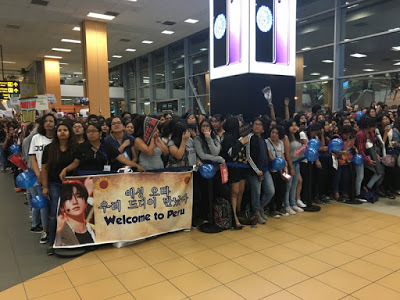
The welcome banner I received:
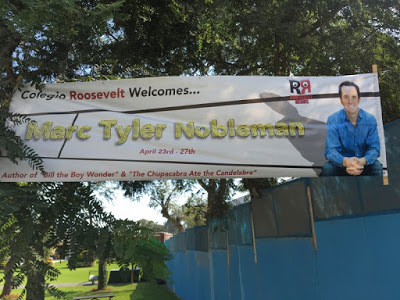
Though the singer had more people waiting for him at the airport than I did, I like my banner better.
It almost never rains in Peru but I was showered by good fortune. My kind host Barbara Bowman is Indiana Jones—an educator who leads a double life as an adventurer.
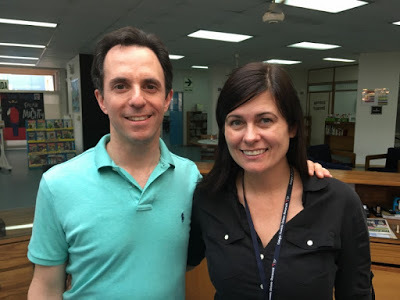
She's spotted a jaguar in the wild (so rare that not even her Peruvian guide who grew up in the jungle had) and slept in Antarctica without a tent.
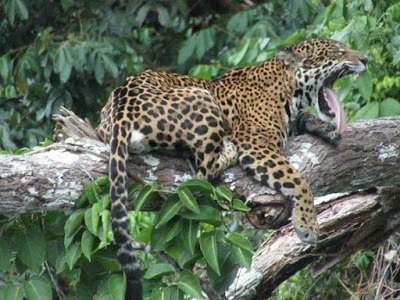 Yes, Barbara took this photo.
Yes, Barbara took this photo.
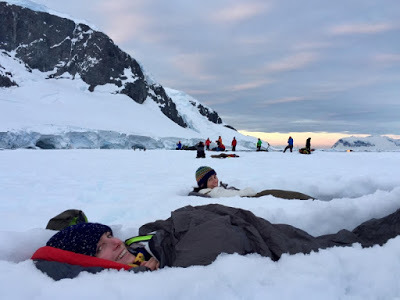
We first connected in 2015, when she was in Vietnam; I ended up visiting that school, but after she left. I'm so thrilled she made it possible for me to see Peru and join an illustrious group.
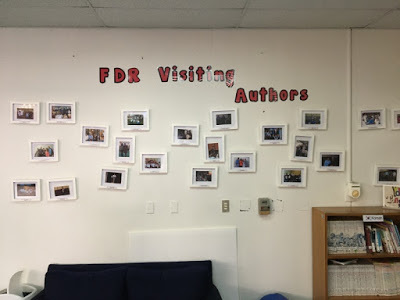
The students, largely Peruvian, were equally welcoming and eager to learn more about the writing process, a focus of the school.
According to a fifth grader who toured me around the school my first morning, the most dangerous thing there is not robbers or earthquakes but the sun. Apparently the ozone layer there (and along the equator in general) is particularly thin, meaning our bodies are exposed to higher levels of ultraviolet radiation than elsewhere.
Wish I knew that the day after I arrived, which was the day before I started work at the school. That afternoon, I walked about 15 minutes from my hotel to tour a striking site, Huaca Pucllana. Alas, the hourlong tour I took was out in the open and I'd worn no sunscreen.
Huaca Pucllana is the ruins of a sizable pre-Incan religious site in the middle of the city, which in its day was in the middle of a desert. Yes, Peru in its natural state is a coastal desert. As breathtaking as the sheer vastness of the site is the fact that it remained unearthed until 1981! Prior to that, people used the huge dirt mound that hid it for motocross.


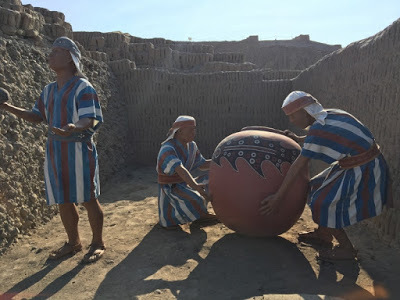
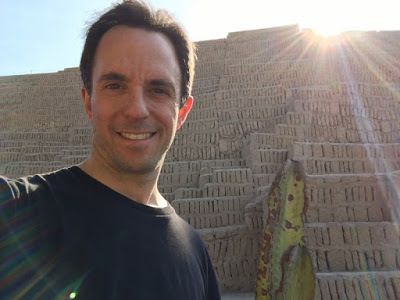
Weeks before I came to Peru, Barbara asked if I would send a short video to help pump up the kids about the visit. In it, I said a) I would probably bring the shirt I was wearing and b) the word "doozy." When I got to the school, multiple kids asked me if I did indeed bring that shirt (I didn't know) and I learned that "doozy" had become a bit of a buzzword at the school. It is a fun word.
The kids bought a lot of books:
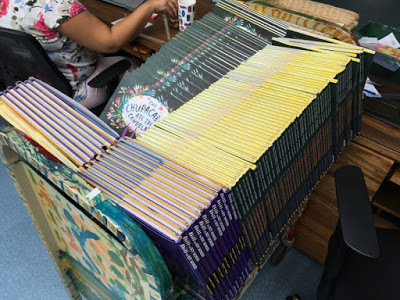
Thanks to Barbara's initiative, the school screened Batman & Bill for families one afternoon:
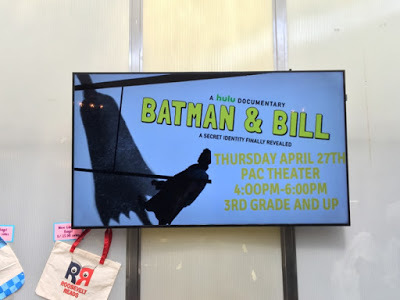
My hotel was a 10-minute walk from the coast—a cliff overlooking a highway running along the ocean. Every night, crowds gather to watch sunsets that are consistently awesome. One night I strolled down to see for myself. It was not the most vivid I've seen, but certainly lovely.

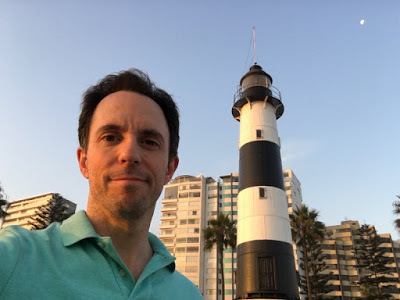
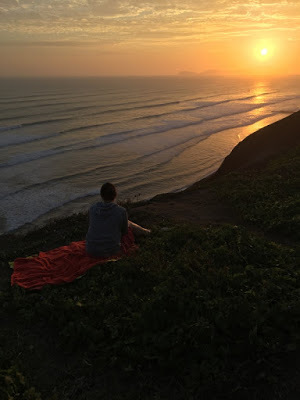
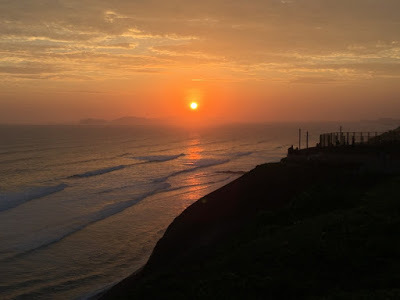
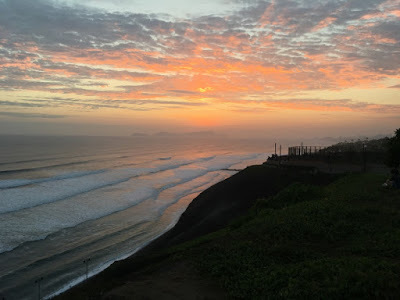
Bizarrely, it turns out that my hotel was also a one-minute walk from the travel agency with whom I'd been emailing for more than a month to arrange my madcap two-night trip to Machu Picchu and Cusco (the city that serves as MP's "base camp 1"). I had not planned to meet my travel agency contact in person, but when I discovered the proximity, I did go in the night before my weekend trip because I was still unclear on certain details. As for my Machu Picchu experience, see mañana.
Thank you again to Barbara and her team for their golden hospitality all week long.
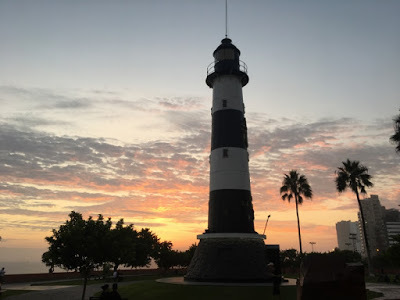
The welcome banner a K-pop singer received the night I arrived:

The welcome banner I received:

Though the singer had more people waiting for him at the airport than I did, I like my banner better.
It almost never rains in Peru but I was showered by good fortune. My kind host Barbara Bowman is Indiana Jones—an educator who leads a double life as an adventurer.

She's spotted a jaguar in the wild (so rare that not even her Peruvian guide who grew up in the jungle had) and slept in Antarctica without a tent.
 Yes, Barbara took this photo.
Yes, Barbara took this photo.
We first connected in 2015, when she was in Vietnam; I ended up visiting that school, but after she left. I'm so thrilled she made it possible for me to see Peru and join an illustrious group.

The students, largely Peruvian, were equally welcoming and eager to learn more about the writing process, a focus of the school.
According to a fifth grader who toured me around the school my first morning, the most dangerous thing there is not robbers or earthquakes but the sun. Apparently the ozone layer there (and along the equator in general) is particularly thin, meaning our bodies are exposed to higher levels of ultraviolet radiation than elsewhere.
Wish I knew that the day after I arrived, which was the day before I started work at the school. That afternoon, I walked about 15 minutes from my hotel to tour a striking site, Huaca Pucllana. Alas, the hourlong tour I took was out in the open and I'd worn no sunscreen.
Huaca Pucllana is the ruins of a sizable pre-Incan religious site in the middle of the city, which in its day was in the middle of a desert. Yes, Peru in its natural state is a coastal desert. As breathtaking as the sheer vastness of the site is the fact that it remained unearthed until 1981! Prior to that, people used the huge dirt mound that hid it for motocross.




Weeks before I came to Peru, Barbara asked if I would send a short video to help pump up the kids about the visit. In it, I said a) I would probably bring the shirt I was wearing and b) the word "doozy." When I got to the school, multiple kids asked me if I did indeed bring that shirt (I didn't know) and I learned that "doozy" had become a bit of a buzzword at the school. It is a fun word.
The kids bought a lot of books:

Thanks to Barbara's initiative, the school screened Batman & Bill for families one afternoon:

My hotel was a 10-minute walk from the coast—a cliff overlooking a highway running along the ocean. Every night, crowds gather to watch sunsets that are consistently awesome. One night I strolled down to see for myself. It was not the most vivid I've seen, but certainly lovely.





Bizarrely, it turns out that my hotel was also a one-minute walk from the travel agency with whom I'd been emailing for more than a month to arrange my madcap two-night trip to Machu Picchu and Cusco (the city that serves as MP's "base camp 1"). I had not planned to meet my travel agency contact in person, but when I discovered the proximity, I did go in the night before my weekend trip because I was still unclear on certain details. As for my Machu Picchu experience, see mañana.
Thank you again to Barbara and her team for their golden hospitality all week long.

Published on May 06, 2018 04:00
April 27, 2018
Kids speaking up…and apologizing
In February, after I indicated that Bill Finger's son Fred was gay while speaking at a Maryland elementary school, a few kids snickered or recoiled. I made clear that we treat all people with respect and the intolerant behavior immediately stopped.
Later that day, Joe, the father of twin girls who were at that assembly, came in to meet with me. He's in a same-sex marriage and was understandably upset that his daughters heard peers react insensitively to an aspect of their family dynamic. Along with the vice principal, we had a difficult, important talk about how to continue to be inclusive in a school setting without putting anyone like Joe's daughters in an uncomfortable situation like that. There are no simple solutions.
I posted about this and Joe (whom I originally called Matt to protect his privacy) commented.
On 4/23/18, Joe sent me a follow-up and gave me permission to post (slightly edited).
This is going to make you cry. In both ways.
What an amazing day and moment. We had a homophobic incident at an author presentation at school. Many students reacted to the word "gay" in a very ugly way. Both my girls were there. They took it pretty rough.
Today, thanks to the leadership and the concern of our wonderful principal and vice principal, and thanks to my friend Jill and her daughter for giving us the idea, my daughters wrote letters to their classmates letting them know how their negative reaction to the mention of LGBTQI people and same-sex couples made my daughters feel. In writing the letter they also were able to express how they felt about being adopted in regards to their classmates' expressions of sadness and questions regarding us as their parents and us as a family. They read their letters to all four fourth grade classes this afternoon.
As their dad I was nervous for them, and this morning I panicked and wanted to put a stop to it. But they both insisted on reading their letters. I can't say enough about how brave I [feel they are] and how much I admire them. And [about] the fact that our school, their teachers, our county, and our state support us as a family and as members of the community. It was a very emotional afternoon. And of course I couldn't help connect it to my experience as a boy in elementary school, afraid of being found out, having no resources to help me understand, and feeling/fearing no support or acceptance from even favorite teachers. I think of the little boys and girls on that carpet today and I feel happy for them. It is a different world, with its problems still, but today is a hopeful day and I'm feeling pretty damn great!
Afterward a girl talked about her gay sister in high school. Then a boy said he was one of the kids who said "Yuck!" when the author [said that Fred Finger was] gay. This boy said he felt bad knowing that he hurt my daughters' feelings. He said he [now] feels different and is sorry for what he said. Another boy said there is no such thing as normal. WOW! All the comments were positive. Fingers crossed that there will not be much parental backlash for the school! I am amazed! Like I said, I'm feeling very hopeful and good about our little part of the world today!
In addition, we may be speaking as family on this incident and its ripples at Howard County Live in June. And our school has decided to have an ongoing policy of letting students write letters about their uniqueness and differences and reading them to their classmates. I think this is a great thing!
I second that.
Joe also allowed me to share the (again lightly edited) letters his daughters bravely shared.
Letter of Joe's daughter A:
I want to talk to you about something that happened a few weeks ago at school. I want to talk about when the author came in and was talking about one of the guys that invented Batman [who] had a gay son who had a daughter. A lot of kids gasped, some people said ew, some people said yuck, and other people started whispering. That made me feel sad and it made me want to cry a little. Afterwards I did cry. I just wanted my daddy to come get me and take me home. Someone in our class said that gay was a bad word. That made me want to cry even more because I have two dads.
On that day in lunch line, three kids were laughing and joking and teasing each other about being gay. That made me feel even sadder and I wanted to yell at them and tell them that they were being very mean and I was really wishing that I could leave school, but I couldn't. When I told a grown-up in the cafeteria about what those kids were saying, she just said OK and she walked away and didn't do anything. I really wanted her to stop them and I really wanted to go home and not come back for a week.
At school some people have told me when they find out that I'm adopted that it is sad that I don't have a mom, or that it's weird that I have two dads. Some people ask me how it is possible that I have two dads and no mother. My sister and I were adopted when we were born. I've seen photos of my mom but I've never met her. I just want all of you to know that it is a little sad, but I love my daddy and my papa and my family and I feel like I am a very happy person. I love when we all hang out together playing family games or watching TV. When other kids at school or on the bus make fun of gay people, it makes me sad, but it also makes me angry and I want to yell at them and tell them there's nothing wrong with it. I want people here to change, to not think it's weird or wrong to have two dads or to be adopted.
I am OK if you ask me questions about my life, I just don't like it if you ask in a way that makes it sound like it's weird or bad or if your response is negative. I am really happy we moved here. I like this school. I have lots of friends and [the] teachers are great. I want to say that my friend J has never teased me or made me feel bad that my family is different.
Thank you for listening to this. My papa says that just because someone is different it doesn't mean that different is bad. He says it's our differences that make life interesting. My daddy says that he wishes he could protect us from all mean people, but he can't, [and] if people ask me questions, I should answer them and try to explain to them. I just hope we can all treat each other with respect and see that if you say something is weird or yucky out loud you might be hurting someone's feelings.
Letter of Joe's daughter G:
I want to talk about the author that came to school. When people made those noises and said things like yuck and ew, it hurt my feelings. I wanted to ask you guys why you would say that because I don't think that being gay is a bad thing. I feel good about having two dads. Sometimes I wish I could meet my mom but it's OK that I have not. I know that in the future I can meet her if she wants to. I feel really nice to be a part of my family, we are a fun family, I mean happy. We are mostly always nice to each other and we take care of each other.
I really don't like it when people make fun of people like my daddy and my papa. I don't think it's the right thing to do. Everybody is different.
I have two dads because I'm adopted. One of my best friends, A, is adopted and she only has a mom, no dad. We have friends that are adopted that have two dads and our neighbors on the next street are two moms with one daughter they adopted.
I wish there were more families like mine at school. Adoption isn't bad or sad. My daddy says there are all kinds of ways to make a family. He was raised by his grandma and grandfather. My papa has a mother and dad and he also has a stepmom. She is one of my papa's best friends. They talk to each other every week.
It's not a nice feeling to be teased or to hear people say bad things about your family. I want everybody here to treat each other nice even if someone is different or their family is different.
Thank you for listening to me.
Note from Dr. Tiffany Tresler, the principal:
Heather [Moraff, the vice principal] and I both agreed that [the letter-sharing] experience was one of the most rewarding and heartfelt moments that we have had in our careers. We both became a bit teary as the [two sisters] shared their letters with their classmates. We told the students that they were tears of joy in how proud we were that they could be so brave to share something so personal to them.
The response from the other students in that moment was so supportive and understanding. We feel so blessed to be a part of this moment of making a difference. The ending was nearly perfect—a student spoke up and said, "I was one of the students who said eww, and now I reflected on that."
As you wrote to us before, "the story continues." We can't wait to see what's next!
Later that day, Joe, the father of twin girls who were at that assembly, came in to meet with me. He's in a same-sex marriage and was understandably upset that his daughters heard peers react insensitively to an aspect of their family dynamic. Along with the vice principal, we had a difficult, important talk about how to continue to be inclusive in a school setting without putting anyone like Joe's daughters in an uncomfortable situation like that. There are no simple solutions.
I posted about this and Joe (whom I originally called Matt to protect his privacy) commented.
On 4/23/18, Joe sent me a follow-up and gave me permission to post (slightly edited).
This is going to make you cry. In both ways.
What an amazing day and moment. We had a homophobic incident at an author presentation at school. Many students reacted to the word "gay" in a very ugly way. Both my girls were there. They took it pretty rough.
Today, thanks to the leadership and the concern of our wonderful principal and vice principal, and thanks to my friend Jill and her daughter for giving us the idea, my daughters wrote letters to their classmates letting them know how their negative reaction to the mention of LGBTQI people and same-sex couples made my daughters feel. In writing the letter they also were able to express how they felt about being adopted in regards to their classmates' expressions of sadness and questions regarding us as their parents and us as a family. They read their letters to all four fourth grade classes this afternoon.
As their dad I was nervous for them, and this morning I panicked and wanted to put a stop to it. But they both insisted on reading their letters. I can't say enough about how brave I [feel they are] and how much I admire them. And [about] the fact that our school, their teachers, our county, and our state support us as a family and as members of the community. It was a very emotional afternoon. And of course I couldn't help connect it to my experience as a boy in elementary school, afraid of being found out, having no resources to help me understand, and feeling/fearing no support or acceptance from even favorite teachers. I think of the little boys and girls on that carpet today and I feel happy for them. It is a different world, with its problems still, but today is a hopeful day and I'm feeling pretty damn great!
Afterward a girl talked about her gay sister in high school. Then a boy said he was one of the kids who said "Yuck!" when the author [said that Fred Finger was] gay. This boy said he felt bad knowing that he hurt my daughters' feelings. He said he [now] feels different and is sorry for what he said. Another boy said there is no such thing as normal. WOW! All the comments were positive. Fingers crossed that there will not be much parental backlash for the school! I am amazed! Like I said, I'm feeling very hopeful and good about our little part of the world today!
In addition, we may be speaking as family on this incident and its ripples at Howard County Live in June. And our school has decided to have an ongoing policy of letting students write letters about their uniqueness and differences and reading them to their classmates. I think this is a great thing!
I second that.
Joe also allowed me to share the (again lightly edited) letters his daughters bravely shared.
Letter of Joe's daughter A:
I want to talk to you about something that happened a few weeks ago at school. I want to talk about when the author came in and was talking about one of the guys that invented Batman [who] had a gay son who had a daughter. A lot of kids gasped, some people said ew, some people said yuck, and other people started whispering. That made me feel sad and it made me want to cry a little. Afterwards I did cry. I just wanted my daddy to come get me and take me home. Someone in our class said that gay was a bad word. That made me want to cry even more because I have two dads.
On that day in lunch line, three kids were laughing and joking and teasing each other about being gay. That made me feel even sadder and I wanted to yell at them and tell them that they were being very mean and I was really wishing that I could leave school, but I couldn't. When I told a grown-up in the cafeteria about what those kids were saying, she just said OK and she walked away and didn't do anything. I really wanted her to stop them and I really wanted to go home and not come back for a week.
At school some people have told me when they find out that I'm adopted that it is sad that I don't have a mom, or that it's weird that I have two dads. Some people ask me how it is possible that I have two dads and no mother. My sister and I were adopted when we were born. I've seen photos of my mom but I've never met her. I just want all of you to know that it is a little sad, but I love my daddy and my papa and my family and I feel like I am a very happy person. I love when we all hang out together playing family games or watching TV. When other kids at school or on the bus make fun of gay people, it makes me sad, but it also makes me angry and I want to yell at them and tell them there's nothing wrong with it. I want people here to change, to not think it's weird or wrong to have two dads or to be adopted.
I am OK if you ask me questions about my life, I just don't like it if you ask in a way that makes it sound like it's weird or bad or if your response is negative. I am really happy we moved here. I like this school. I have lots of friends and [the] teachers are great. I want to say that my friend J has never teased me or made me feel bad that my family is different.
Thank you for listening to this. My papa says that just because someone is different it doesn't mean that different is bad. He says it's our differences that make life interesting. My daddy says that he wishes he could protect us from all mean people, but he can't, [and] if people ask me questions, I should answer them and try to explain to them. I just hope we can all treat each other with respect and see that if you say something is weird or yucky out loud you might be hurting someone's feelings.
Letter of Joe's daughter G:
I want to talk about the author that came to school. When people made those noises and said things like yuck and ew, it hurt my feelings. I wanted to ask you guys why you would say that because I don't think that being gay is a bad thing. I feel good about having two dads. Sometimes I wish I could meet my mom but it's OK that I have not. I know that in the future I can meet her if she wants to. I feel really nice to be a part of my family, we are a fun family, I mean happy. We are mostly always nice to each other and we take care of each other.
I really don't like it when people make fun of people like my daddy and my papa. I don't think it's the right thing to do. Everybody is different.
I have two dads because I'm adopted. One of my best friends, A, is adopted and she only has a mom, no dad. We have friends that are adopted that have two dads and our neighbors on the next street are two moms with one daughter they adopted.
I wish there were more families like mine at school. Adoption isn't bad or sad. My daddy says there are all kinds of ways to make a family. He was raised by his grandma and grandfather. My papa has a mother and dad and he also has a stepmom. She is one of my papa's best friends. They talk to each other every week.
It's not a nice feeling to be teased or to hear people say bad things about your family. I want everybody here to treat each other nice even if someone is different or their family is different.
Thank you for listening to me.
Note from Dr. Tiffany Tresler, the principal:
Heather [Moraff, the vice principal] and I both agreed that [the letter-sharing] experience was one of the most rewarding and heartfelt moments that we have had in our careers. We both became a bit teary as the [two sisters] shared their letters with their classmates. We told the students that they were tears of joy in how proud we were that they could be so brave to share something so personal to them.
The response from the other students in that moment was so supportive and understanding. We feel so blessed to be a part of this moment of making a difference. The ending was nearly perfect—a student spoke up and said, "I was one of the students who said eww, and now I reflected on that."
As you wrote to us before, "the story continues." We can't wait to see what's next!
Published on April 27, 2018 04:00
April 26, 2018
Especially proud of this debut nonfiction picture book author
In October 2017, I heard from Laura Dershewitz, a friend-of-a-friend who was inspired by a recent obituary to try to write a nonfiction picture book for the first time. I stammered out some halfway incoherent advice and wished her luck.
It was just announced that she and her writing partner SOLD THE BOOK. See what can happen when you just go for it?

Congrats Laura Dershewitz, Susan Romberg, and Meghann Rader! I can't wait to read about the self-cleaning house...and not just because I'm a neat freak.
It was just announced that she and her writing partner SOLD THE BOOK. See what can happen when you just go for it?

Congrats Laura Dershewitz, Susan Romberg, and Meghann Rader! I can't wait to read about the self-cleaning house...and not just because I'm a neat freak.
Published on April 26, 2018 04:00
April 25, 2018
Inaugural speaker for Pat Scales lecture series at University of Montevallo
On 4/19/18, I had the honor of being the inaugural speaker for a lecture series at the University of Montevallo. It's outside Birmingham, Alabama, a city I'd visited for the first time only a month before, for (elementary) school visits. The university used to be all-female; males began to attend through the G.I. Bill (apparently all-male and coed campuses did not have enough slots to accommodate the number of men returning from WWII).
The lecture was part of a larger event called the Forte Festival of Creativity. Its theme was "Heroes and Heroines."
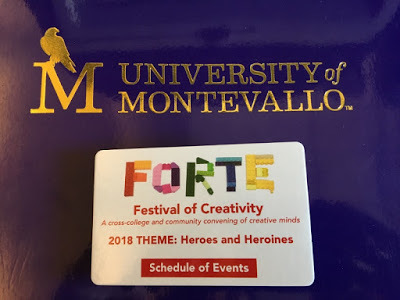
In a case of near-perfect timing, the day of the lecture was 80 years and a day after Superman debuted in Action Comics #1 (April 18, 1938). A lovely group of educators, students, and other community members attended.
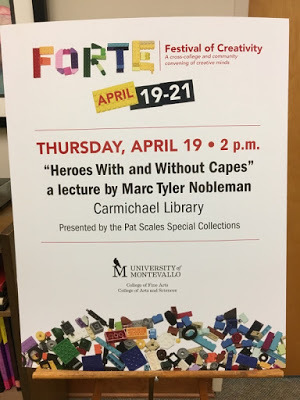
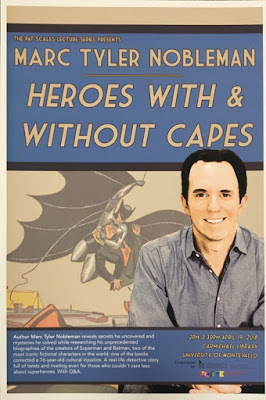
I've not met Pat Scales but I hope to. She attended Montevallo and went on to become an advocate for intellectual freedom and a crusader against censorship. I delivered the lecture in a room in the library newly created to house Pat's generous donation of papers and children's books.
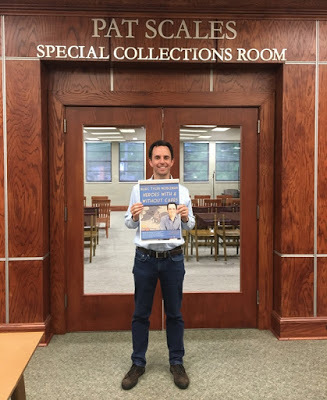
The room was bedecked with fantastic vintage Book Week posters. I wanted every one of them.
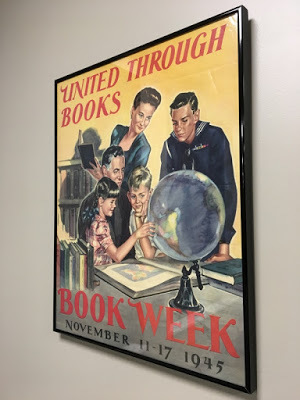
I was further heartened to learn that Montevallo attracts students who did not feel they could be themselves out loud in high school in the South, such as those who identify as LGBTQ. The campus was clearly open-minded and artistic.
And not-so-clearly haunted.
Around 9 p.m. the night before my lecture, I was taken to where I'd spend the night: the King House.
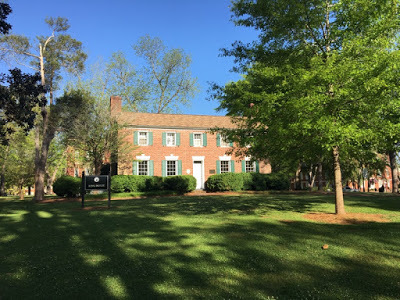
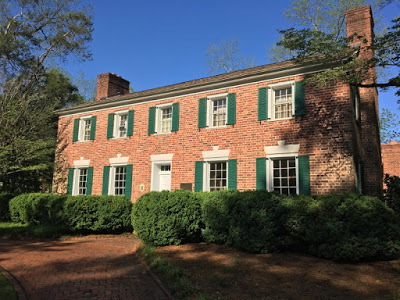 Note: This is not what it looks like at night.
Note: This is not what it looks like at night.
Built in 1823, it was one of the first houses in Alabama with glass windows. It sits in the middle of campus where it has developed a reputation for being a hotbed of paranormal activity. One of those ghost-hunting shows filmed there…and picked up readings.
The woman who showed me around the house did not bring this up on her own, but when I asked, she was more than happy to share stories…even though I was about to stay there by myself. Again, I brought it upon myself!
She said grown men have refused to step foot in the house. One guest saw a black faceless humanoid form hovering over the very bed I would sleep in. A notable author called campus police at 1 a.m. and asked to be taken to a hotel (the nearest of which was, I believe, about 30 miles away). Some have reported seeing Mr. King himself walking his former property with a lantern, perhaps looking for the gold he'd allegedly buried centuries ago.
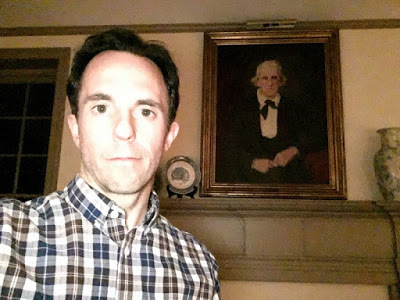
I was told I may see Mr. King (the gentleman behind me) later that night…and not in a painting.
Even though I am interested in ghosts and have written about ghosts and have long wanted to experience something ghostly, I was a bit spooked staying alone in that house. I admit I left on the downstairs hall light and the bathroom light on the second floor, adjacent to the room in which I would sleep. Scaredy-cat and Mr. King.
Around midnight, when I was still up, I heard one unusual bang downstairs, as if someone had dropped something heavy. I did not go investigate.
Morning came without other additional incident—at least any I was aware of.
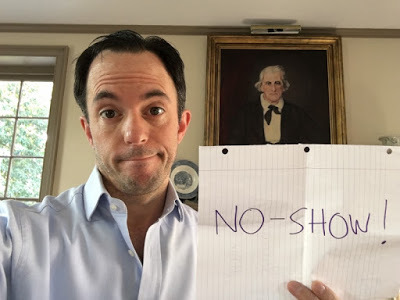
This was both fortunate and unfortunate.
One of the students who heard me present saw my social media post and reacted in charming disbelief.

King House is not the only campus location with ghost sightings. In 1908, a student named Condie Cunningham caught on fire in her dorm room and ran down the hallway in panic, later dying from her injury. Some have reported that she is still around—and that her face "burned" into the door of what was her room. The door has been removed and is now stored in the campus archives.
Wondering about the possible implications of taking a photo of it, I hesitated at first. Then I figured that because I survived King House, maybe I'm not an unwelcome presence among the unexplained of Montevallo.
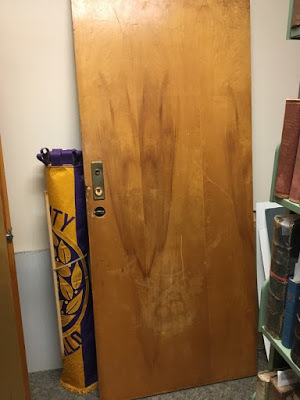
Thank you again to Anna Mary Williford for inviting me to Montevallo. Your introduction humbled and tickled me; thank you for allowing me to quote part of it (lightly edited):
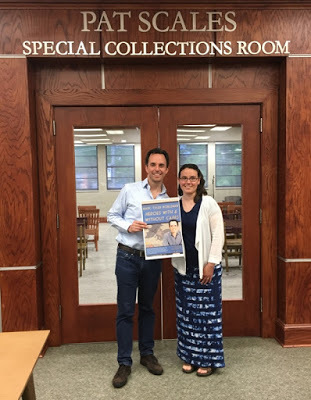
And thank you again to the plethora of Montevallo staff and students for extending me such a warm welcome.
If I come back, I want another shot at the King House…
The lecture was part of a larger event called the Forte Festival of Creativity. Its theme was "Heroes and Heroines."

In a case of near-perfect timing, the day of the lecture was 80 years and a day after Superman debuted in Action Comics #1 (April 18, 1938). A lovely group of educators, students, and other community members attended.


I've not met Pat Scales but I hope to. She attended Montevallo and went on to become an advocate for intellectual freedom and a crusader against censorship. I delivered the lecture in a room in the library newly created to house Pat's generous donation of papers and children's books.

The room was bedecked with fantastic vintage Book Week posters. I wanted every one of them.

I was further heartened to learn that Montevallo attracts students who did not feel they could be themselves out loud in high school in the South, such as those who identify as LGBTQ. The campus was clearly open-minded and artistic.
And not-so-clearly haunted.
Around 9 p.m. the night before my lecture, I was taken to where I'd spend the night: the King House.

 Note: This is not what it looks like at night.
Note: This is not what it looks like at night.Built in 1823, it was one of the first houses in Alabama with glass windows. It sits in the middle of campus where it has developed a reputation for being a hotbed of paranormal activity. One of those ghost-hunting shows filmed there…and picked up readings.
The woman who showed me around the house did not bring this up on her own, but when I asked, she was more than happy to share stories…even though I was about to stay there by myself. Again, I brought it upon myself!
She said grown men have refused to step foot in the house. One guest saw a black faceless humanoid form hovering over the very bed I would sleep in. A notable author called campus police at 1 a.m. and asked to be taken to a hotel (the nearest of which was, I believe, about 30 miles away). Some have reported seeing Mr. King himself walking his former property with a lantern, perhaps looking for the gold he'd allegedly buried centuries ago.

I was told I may see Mr. King (the gentleman behind me) later that night…and not in a painting.
Even though I am interested in ghosts and have written about ghosts and have long wanted to experience something ghostly, I was a bit spooked staying alone in that house. I admit I left on the downstairs hall light and the bathroom light on the second floor, adjacent to the room in which I would sleep. Scaredy-cat and Mr. King.
Around midnight, when I was still up, I heard one unusual bang downstairs, as if someone had dropped something heavy. I did not go investigate.
Morning came without other additional incident—at least any I was aware of.

This was both fortunate and unfortunate.
One of the students who heard me present saw my social media post and reacted in charming disbelief.

King House is not the only campus location with ghost sightings. In 1908, a student named Condie Cunningham caught on fire in her dorm room and ran down the hallway in panic, later dying from her injury. Some have reported that she is still around—and that her face "burned" into the door of what was her room. The door has been removed and is now stored in the campus archives.
Wondering about the possible implications of taking a photo of it, I hesitated at first. Then I figured that because I survived King House, maybe I'm not an unwelcome presence among the unexplained of Montevallo.

Thank you again to Anna Mary Williford for inviting me to Montevallo. Your introduction humbled and tickled me; thank you for allowing me to quote part of it (lightly edited):
I have been at the University of Montevallo for just over a year now. Prior to that, I was a librarian at the University of Pittsburgh at Greensburg in Pennsylvania where I had the pleasure of coordinating their annual children's literature conference, which is where I met Marc. About a year before the conference, I received the first of what would be many emails with subject lines like, "Batman at Pitt Greensburg in 2015?" or "Batman, you know. Superman, you know. Nobleman, you will know." And I would think to myself, "Who is this guy who will not stop emailing me?!" I booked him as one of our keynote speakers for May 2015, a decision that I've never regretted!
But I will admit that at the time, I assumed his persistence was simply because he was doing his job, part of which was promoting the books he'd written. After hearing Marc speak, though, I realized that presenting his work was so much more than "part of the job" to him. Sharing his research with a wider audience was an essential part of his quest for the truth about Batman to finally be acknowledged. For a lot of authors, simply publishing Bill the Boy Wonder might have been enough—the book was out there now, people could read it and learn about what happened for themselves. But that wasn't enough for Marc, who wants to personally deliver his message to as many people as possible. I'm pretty sure that he set out to turn every student, teacher, librarian, or conference attendee who crossed his path into a soldier in his army for justice for the legacy of Batman, and I think that's exactly what he's accomplished over the past few years.
So when I watched Batman & Bill, I had to laugh at the fact that the first word Marc's wife uses to describe him is "persistent," as he is definitely one of the most persistent people I've ever met, but in a good way! That persistence is why he's here with us today, in more ways than one.
That's the passion Marc has for his work, and it will come across when you hear him speak in just a minute. On the subject of passionate folks, Pat Scales unfortunately couldn't join us this afternoon. However, she is familiar with—and a fan of!—Marc's work, and I am certain she'd be pleased with the fact that the inaugural speaker in the lecture series named for her is someone who shares many of the same values she's championed throughout her career: the desire to see the truth prevail; the importance of literacy and education; a calling to correct injustice, whether that injustice comes in the form of a banned or challenged book or a buried legacy just waiting to be uncovered and brought to light.

And thank you again to the plethora of Montevallo staff and students for extending me such a warm welcome.
If I come back, I want another shot at the King House…
Published on April 25, 2018 04:00



